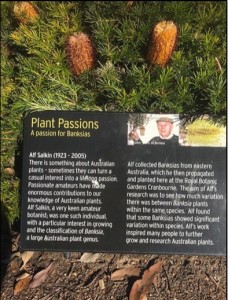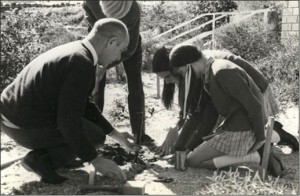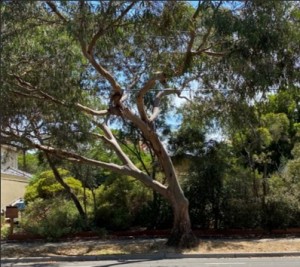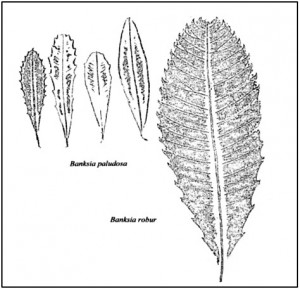Alf Salkin (1923-2005) was a teacher in Victorian Education Department secondary schools from 1964 until 1985. He taught at Mount Waverley, Monash and Brentwood high schools. He was primarily an art teacher but late in his career he also taught science. His contributions to environmental education were extensive and stretched well beyond school teaching. He was a significant teacher and scholar in the recent history of environmental education in Australia.
Salkin was born in Manchester and attended the Grecian Street elementary school where one of his teachers introduced him to the study of plants, sparking an interest that would become a major part of his later life. He left school when he was fourteen and became a fitter and turner. He later joined the Royal Air Force, flying Spitfires during World War II. He migrated to Australia in 1949, trained as an art teacher and started teaching in the 1960s. He developed his environmental passion almost immediately after emigrating from Britain, travelling extensively to experience a range of Australian environments, initially by bicycle with his brother Ivor and later with his wife Esma.
The rise of environmentalism
Salkin was active in the fields of botany, conservation and environmental education during a time when environmental awareness and concern became much more prevalent in Australia than they had been in previous times. Key reasons for this expansion included directly observable environmental degradation, the publicising of such in various media and the development of environmental education. Increasing affluence and an accompanying growth of leisure time for many people enabled them to engage in environmental activities. Also of importance was the rise of political unrest, such as protests against the Vietnam War, and a new activism associated with various social movements. Among these movements was the environmental movement, a movement that remains concerned with safeguarding the natural environment by attempting to influence individual environmental behaviour and broader political processes by combinations of lobbying, activism and education.
Salkin’s numinous experiences
As well as the global and local catalysts of Salkin’s endeavours, his own numinous/spiritual experiences forged his environmental outlook. For many people, such experience of the natural environment induces both personal awe, the enhancing of pro-environment behaviour and scientific interest. Such emotional responses to nature are often experienced by people who are advocates of the preservation or complete protection of substantial areas of the natural environment. At the core of this attitude is the belief that the natural environment has intrinsic worth and that people may carefully use some parts of the environment only for recreation and inspiration, and not as an exploitable economic resource. Alf Salkin was an advocate of this approach.
After experiencing two weeks of discomfort and deprivation in the rugged south-west of Tasmania, Salkin wrote in his diary:
Reading through this diary, I find it hard to grasp how primitive our life has been over the past two weeks, how close to the earth and reality we have been. For out there is the real world, this an unconscious world of our own desires, built to keep out those elements of uncertainty that we had been experiencing.
Many times people ask us ‘Why do you go, why endanger your life when you can live so comfortably in the city?’ How can you explain? It’s not just the scenery, nor the exercise though both are present. It’s like a revelation, a vision, a perspective of the value and meaning of life (Salkin diary, 1955/1956).
Salkin certainly expressed his “perspective of the value and meaning of life” through his subsequent pro-social and generous contributions to botany and conservation. His environmentally educative role was inextricably linked to these commitments. Salkin was fortunate that Victorian schools and even individual teachers were relatively free to develop their own syllabi, until the senior secondary years, over the time of his teaching career. Consequently, he was able to choose topics of interest to him, particularly selecting those with a natural environment component.
Salkin’s contributions to botany

Alf Salkin commemorative plaque, Cranbourne Gardens, 2020. (Photo: Garry Price)
Alf Salkin’s contributions to botany embraced both academic and popular spheres. His academic study of Banksia taxonomy, in particular his study of the topodemes [i.e. the population occupying a specified geographical range] of Banksia canei, led to his obtaining a Master of Science degree and the publication of articles in academic journals. His establishment of the Special Collections Area (SCA), an area of educational and scientific importance, at the Royal Botanic Gardens Cranbourne (now Cranbourne Gardens) in 1977, allowed for further research on Banksia characteristics and for research on other genera such as Correa. His academic endeavours contributed new knowledge to botany. Furthermore, as stated on his commemorative plaque at the Cranbourne Gardens, “Alf’s work inspired many people to further grow and research Australian plants.”
Salkin the environmental inspirer and community educator

Banksia in the Special Collections Area, Cranbourne Gardens, c. 1987. (Photo: Elaine Herbert)
Salkin’s greatest contributions to botany occurred beyond the academic realm and enhanced environmental education. For example, the SCA inspired other activities such as photography, further boosting appreciation of the natural environment. Photographs of the SCA by Elaine Herbert, a former science teacher and an Associate of the Royal Photographic Society, demonstrated how a degraded and harsh environment could be revegetated with appropriate planting.
Salkin was eager to extend his contributions to environmental education beyond school settings. He contributed to environmental education in the broader community by increasing popular knowledge of Banksias through publications of the Society for Growing Australian Plants and articles on the history of their European discovery and naming (Salkin, 1981/1982, Parts I-VI).
His willingness to share his botanical knowledge, to supply plant material and to demonstrate propagation techniques contributed to the expansion of amateur botany and environmental education in Australia. As stated in a tribute given after he died in 2005: “he provided a wealth of information and inspiration by giving talks or writing articles on many aspects of native plants, and their habitats” (Greig, 2005).

Alf Salkin with students planting a native garden, Mount Waverley High School, c.1969. (Salkin family photograph collection.)
Salkin also made extensive contributions to the conservation of the environment and attendant environmental education. One example of his practical approach to conservation and to environmental education was his planting, with the aid of students, Australian plants in the grounds of Mount Waverley High School during the 1960s. The area of extensive planting was later named the ‘Alf Salkin Reserve’ in his honour. It continues to thrive (2023) and is used for educative purposes.
Community and private conservationist
Salkin was also keen to expand community environmental education through community conservation activities. An example included his establishment in 1982 of, and long-term commitment to, ‘Friends of Valley Reserve’. Valley Reserve is a 15-hectare bushland reserve in Mount Waverley with both high conservation and recreational significance. As Salkin stated “we have gradually educated them [Monash Council] to see the reserve as a special place” (Waverley Gazette, 14 April 2001). His dedication to this cause was subsequently recognised by the naming of a landing in Valley Reserve after him.

Part of Salkin’s private property, Mount Waverley. 2022. (Courtesy of photographer, Garry Price.)
A further example of Salkin’s environmental commitment was the demonstration of conservation and ensuing environmental education through small-scale planting on the Salkins’ suburban allotment in Mount Waverley, a garden that inspired people to emulate the model.
Salkin and ecosystem conservation
From a scientific perspective, Salkin’s greatest contribution to conservation arose from his research into the topodemes of Banksia canei. This research contributed to understanding the need to consider provenance scientifically when undertaking revegetation projects in ecologically sensitive areas. Regeneration is now seen as a more complex concept than the simple ‘plant local’ model. Salkin contributed substantially to the development of this concept of provenance and consequently to ecosystem conservation.
Salkin’s contributions to environmental education
Alf Salkin believed that the natural world has intrinsic value, and this over-arching principle guided his approach to environmental education, both in school settings and in the wider community. He recognised that environmental education and the consequent development of environmental literacy in society are important contributors to the quest for sustainable development. The needs of the present should be met without compromising the ability of future generations to meet their needs.
Salkin was keen to prepare students to take an active role in moving towards the goal of sustainable development. Accordingly, he based his teaching on the theories of learning that emphasised the need to align learning with real-life social and physical settings, such as those of John Dewey (1958, originally 1916) and Albert Bandura (1986). His actions as a teacher were at the forefront of environmental education initiatives.
Environmental education was experienced by relatively few students during the time of Salkin’s teaching career (Price, 2019). Salkin attempted to ameliorate this state of affairs by capitalising on the relative curriculum freedom in Victorian secondary schools and choosing topics of interest to him, especially those with a natural environment component in his art classes. He subscribed passionately to the belief that art is an important element of modern environmentalism.

Leaf prints of Banksia paludosa and robur. (From Salkin & Blake, 1974, p. 15.)
Salkin used aspects of the environmental art emanating from America in the 1960s and 1970s as inspiration in his art classes, with students producing, for example, ‘environmental’ sculptures, particularly from natural materials. He also acquainted his students with the works and lives of Australian artists such as Clifton Pugh and Neil Douglas in his attempts to create greater environmental awareness among the student cohort. Furthermore, he increased environmental awareness in his art students by discussing the distribution and variation of Banksias (his favourite topic) and having students make leaf prints of various species.
Significance of Salkin’s work
Salkin’s environmental beliefs and attitudes led to his extensive commitments to botany and conservation. His environmentally educative role, in, about and for the environment, was inextricably linked to these commitments. His endeavours to raise environmental consciousness were at the forefront of environmental education initiatives, both in schools and in the general community.
